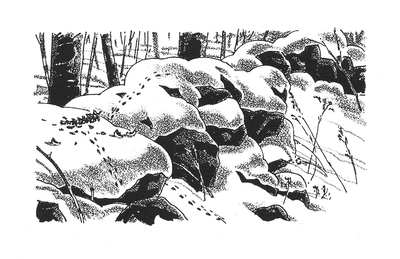| An enthusiastic group of five braved the wind and cold for a trek of less than a mile in a foot and a half of fresh snow. The highlight of the trip was the discovery of an active red fox den with tunnel and lay sites. The location had been visited by coyotes as well, which left a sizable scent mark. The remains (fur and blood) from a red squirrel were also found at this location. At the end of the walk through dense undergrowth a trail that had been snowed on and blown in showed many characteristics of bobcat behavior although there was not enough evidence for a certain identification. | |

Species whose tracks or sign were found:
- Red fox: tracks, trails and den.
- White-tailed deer: tracks
- Eastern coyote: tracks, trails and scent marks
- Snowshoe hare: tracks, trails, scat
- Porcupine: tracks and trails
- White-footed mouse: tracks and trails, tunnels
- Red-squirrel: tracks, trails, cache tunnels
- Gray squirrel: tracks, trails, feeding sign
- Bobcat: probable snow-filled trail
- The effects of deep, soft snow on animal gaits and the resulting track and trail appearance.
- The “heimal threshold” of 8” snow depth and its effect on animals seeking the insulation of deep snow as well as its protection from predators.
- The effect of different consistencies of snow on the ability of predators to detect sub-nivean prey.
- The value of older growth forests for the many species that use tree cavities for denning and nesting.
- Odor of the urine scent marks of red fox, coyote and deer.
- Different feeding behaviors of red and gray squirrels.
- Use of raised linear features (stone wall and fallen logs) by various predators, mainly bobcats, gray foxes and fishers.
- Varying degrees of hibernation from profound (woodchucks and jumping mice) to periodic torpor for raccoons and skunks to momentary torpor for birds.
- Denning behavior for red foxes.
